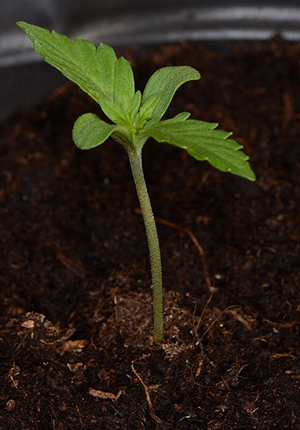

Organic Gardening
Many new gardeners make the mistake of paying all of their attention to the parts of the plant that they can see. When problems appear above the soil surface, sometimes the root of the problem is actually occurring below ground. Plants need a strong and healthy root system much like you need a foundation under your house for it to not collapse. To insure a strong and healthy root system, you should start a preventative maintenance program on day one.
The 3 basic factors that contribute to the cannabis plant’s ability to grow in soil are: The soil texture, nutrient content, and pH. If you have decided to grow with soil in the grow room, you will want a potting soil that has a good texture to promote drainage so that your plants roots receive air as well as water and nutrients. Plant roots that sit in a soggy soil for extended periods are prone to insect damage and rot caused by fungal attacks (pythium). Most name brand commercial potting soils will work well in the grow room, avoid the cheap stuff unless you want every undesirable insect hatching out of the soil and taking up residence in your garden.
The different varieties of cannabis can have different reactions to the high end potting soils. If the potting soil is “hot”, meaning loaded with organic nutrients, and you are growing a variety of cannabis that is on the sensitive side when dealing with nutrients, your plants can exhibit signs of growing medium stress like downturned leaf tips. Sometimes those soils work better when used as an additive to potting soils that are more neutral.
Many of the higher end potting soils are also going to contain dolomite lime which helps to balance the pH around 6.5. Cannabis grows best in soil with a pH from 6.3-6.6. Within this range cannabis can properly absorb and process the available nutrients efficiently. If the pH is too low (acidic), the macro-nutrients become chemically bound and the roots are unable to absorb them. Soils with a high pH (alkaline), can lock out many of the micro-nutrients. If your soil does not contain dolomite lime, you can add 1 cup per cubic foot of soil to stabilize the soils pH. Checkout the Cannabis Nutrients and Indoor Gardening Basics pages for more information about pH.
When growing organically, I recommend maintaining a feeding schedule of: feed with nutrients, then on the next watering use water only and then repeat during the growing season. Following this routine will give your plants plenty of time to assimilate the available nutrients.
Hydroponic Gardening
Hydroponics is the science of growing plants without soil. With hydroponics, nutrient uptake and grow medium oxygen levels can be controlled easily. If you can manage these 2 factors, along with a few of the other basic requirements, you will be successful cultivating indoors.
The inert soilless hydroponic mediums commonly used by indoor growers do not contain nutrients like you find in organic mediums. All the nutrients are supplied via a nutrient solution made up of fertilizers and water. The nutrient solution passes over or floods and drains the plant’s root system at scheduled intervals. The extra oxygen that is trapped within the soilless medium and around the roots speeds up nutrient uptake by the delicate root hairs. Cannabis grows fast when grown hydroponically because it is able to take in nutrients as fast as they can be used. Even the best draining soils rarely supply plant roots with as much oxygen compared to a hydroponic system.
Hydroponic systems are distinguished by the way the nutrient solution is applied. The 2 main types of hydroponic systems are the passive and the active. Passive systems rely on capillary action to transfer the nutrient solution from the reservoir to the growing medium. The nutrient solution is then passively absorbed by a wick or growing medium and transported to the plant roots. In active hydroponic systems, the nutrient solution is actively moved from a reservoir to the growing medium via a water or an air pump. The most common types of active hydroponic systems are the flood and drain, and the top feed drip emitters.
There is a misconception that growing hydroponically is less work because it utilizes automated systems, but that is not the case. Growers spend more time managing the nutrient solution, making sure that the pH (5.8-6.5) and TDS PPM (Total Dissolved Solids/Parts Per Million) stay within the proper range. Due to the extra hardware used with hydroponic systems, there is the possibility for more things to go wrong, and regular maintenance will be needed. Since the plants grow faster in a hydroponic setup, they too will have a higher maintenance level. But once you have your system dialed in, you will benefit by a generous yield come harvest time.

